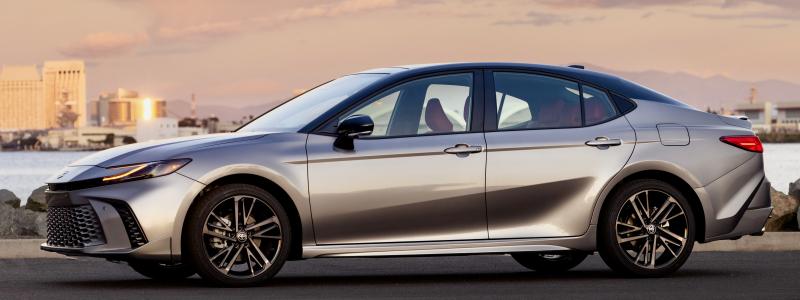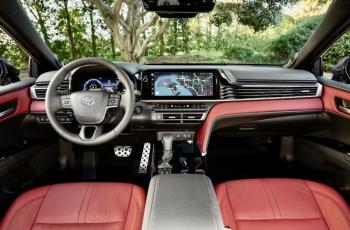Toyota Camry XSE AWD

Three things about this car jump out right away, or shortly after: First, it’s near-gorgeous—far sexier than a mainstream sedan needs to be. Second, poking the START button lights up the instruments, but not the engine; this is a gas-electric hybrid. And third (this is the bit that comes up after a couple of miles), this roomy midsize four-door car can knock off about 45 miles per gallon.
Well, of course it can. Toyota has applied its 27 years of experience with the Prius to the Camry, which henceforth—as of this 2025 model—is available only as a hybrid. A friend who drives a Porsche sniffed, “It sounds like a sewing machine!” If by that he means it’s smooth and near-silent, I agree, and it is good.
This is the all-wheel-drive version, so our Camry comes with three motors. The gas-burner under the hood has four cylinders that displace 2.5 litres, and to it is mated a 100-kilowatt electric motor; at the back, driving the rear wheels, is another electric motor, rated for 30 kilowatts. Altogether, they produce 232 horsepower. Toyota won’t say how much torque is available, so I’ll guesstimate and say “plenty.”
Front-wheel-drive Camrys make do with 225 horsepower. Both drivetrains include a continuously variable automatic transmission with a sport mode and shift paddles that let the driver play with the six programmed “gears.”
Hidden away somewhere is a 600-volt, 4.0-amp/hour 68-cell battery pack that must be uncommonly energy-dense because in total this Camry weighs just 3,700 pounds, even with all-wheel drive. This is what we’d expect from a gas-only car, not a three-motors-plus-battery hybrid. This contributes to the car’s exemplary fuel efficiency and speaks to how well Toyota has learned to package two powertrains into one.
It's not a plug-in hybrid; the internal-combustion engine charges the batteries while underway, at a time and in a manner determined by a computer system that helps render the entire operation transparent, seamless and noiseless. There is no juddering, however subtle, when the gas engine comes to life (or goes to sleep); Toyota doesn’t even provide a Prius-like computer screen that shows energy flow and which motors are doing what. Naturally, the oddball controls, wooden brakes, lifeless steering and ultralight-aircraft feel of early Toyota hybrids are long gone too.
Particularly in XSE trim, and with the $4,075 Premium Plus package with red leather upholstery, this Camry feels almost deluxe, not to say roomy and comfortable. The electric motors provide pleasing off-the-line grunt as well as high gas mileage, the driver’s seat is unusually adjustable, the new styling delights the eye and the driving experience is serene. If it seems odd that GPS navigation is not built in, turn-by-turn directions are available through Apple CarPlay and Android Auto, which require a wireless smartphone connection.
Four trim levels of Camry are available for 2025; all are four-door sedans and AWD is a $1,525 option on each. The entry-level LE starts at $29,495 with destination fee, the SE at $31,795, the XLE at $34,495 and the XSE at $35,695. Our sample XSE, however, with AWD and the Premium upgrade, bears an MSRP of $44,569—which is about four grand less than today’s average new-car price.
This is the ninth generation of the Camry, which Toyota introduced to the world in 1982. In the late ‘90s, before she became the blind lady, my wife owned a champagne-colored fourth-gen Camry that she adored. Giving it up, when her vision deteriorated to the point that she had to turn in her driver’s license, about broke her heart. Otherwise, knowing her, that car might still be with us today.
Next week: Hyundai Tucson LTD































